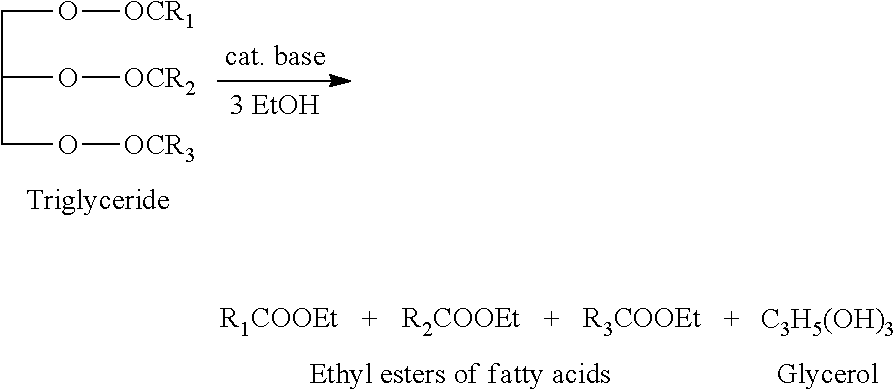Genetically engineered microorganisms that metabolize xylose
a technology of xylose and microorganisms, applied in the direction of peptides, climate sustainability, dna/rna fragmentation, etc., can solve the problems of biotechnology unleashing the vast potential of carbon capture, and most yeast strains either cannot utilize xylose or only very inefficiently utilize xylos
- Summary
- Abstract
- Description
- Claims
- Application Information
AI Technical Summary
Benefits of technology
Problems solved by technology
Method used
Image
Examples
example 1
Methods for Culturing Prototheca
[0299]Prototheca strains were cultivated to achieve a high percentage of oil by dry cell weight. Cryopreserved cells were thawed at room temperature and 500 ul of cells were added to 4.5 ml of medium (4.2 g / L K2HPO4, 3.1 g / L NaH2PO4, 0.24 g / L MgSO4.7H2O, 0.25 g / L Citric Acid monohydrate, 0.025 g / L CaCl2 2H2O, 2 g / L yeast extract) plus 2% glucose and grown for 7 days at 28° C. with agitation (200 rpm) in a 6-well plate. Dry cell weights were determined by centrifuging 1 ml of culture at 14,000 rpm for 5 min in a pre-weighed Eppendorf tube. The culture supernatant was discarded and the resulting cell pellet washed with 1 ml of deionized water. The culture was again centrifuged, the supernatant discarded, and the cell pellets placed at −80° C. until frozen. Samples were then lyophilized for 24 hrs and dry cell weights calculated.
[0300]For determination of total lipid in cultures, 3 ml of culture was removed and subjected to analysis using an Ankom syste...
example 2
Methods for Transforming Prototheca
[0308]A. General Method for Biolistic Transformation of Prototheca
[0309]S550d gold carriers from Seashell Technology were prepared according to the protocol from manufacturer. Linearized plasmid (20 μg) was mixed with 50 μl of binding buffer and 60 μl (30 mg) of S550d gold carriers and incubated in ice for 1 min Precipitation buffer (100 μl) was added, and the mixture was incubated in ice for another 1 min. After vortexing, DNA-coated particles were pelleted by spinning at 10,000 rpm in an Eppendorf 5415C microfuge for 10 seconds. The gold pellet was washed once with 500 μl of cold 100% ethanol, pelleted by brief spinning in the microfuge, and resuspended with 50 μl of ice-cold ethanol. After a brief (1-2 sec) sonication, 10 μl of DNA-coated particles were immediately transferred to the carrier membrane.
[0310]Prototheca strains were grown in proteose medium (2 g / L yeast extract, 2.94 mM NaNO3, 0.17 mM CaCl2.2H2O, 0.3 mM MgSO4.7H2O, 0.4 mM K2HPO4,...
example 3
Generation of a Microalgal Strain Capable of Metabolizing Xylose
[0311]Methods and effects of expressing a heterologous exogenous gene in Prototheca species, including, for example, codon optimization and chromosomal recombination sites, have been previously described in PCT Application No. PCT / US2009 / 66142, hereby incorporated by reference, for these teachings. This example demonstrates the generation of a transgenic strain derived from Prototheca moriformis (UTEX 1435) containing exogenous genes for the metabolism and transport of xylose. The resulting transgenic Prototheca strain generated had the ability to grow on media containing xylose as the sole carbon source. As discussed above, the ability to metabolize xylose is important because xylose, a pentose, is a significant component of cellulosic-derived feedstocks. Xylose is the major sugar monomer component of hemicellulose, which, along with cellulose, forms the major structural components of most plant matter.
[0312]Preliminar...
PUM
| Property | Measurement | Unit |
|---|---|---|
| volumes | aaaaa | aaaaa |
| concentration | aaaaa | aaaaa |
| concentration | aaaaa | aaaaa |
Abstract
Description
Claims
Application Information
 Login to View More
Login to View More - R&D
- Intellectual Property
- Life Sciences
- Materials
- Tech Scout
- Unparalleled Data Quality
- Higher Quality Content
- 60% Fewer Hallucinations
Browse by: Latest US Patents, China's latest patents, Technical Efficacy Thesaurus, Application Domain, Technology Topic, Popular Technical Reports.
© 2025 PatSnap. All rights reserved.Legal|Privacy policy|Modern Slavery Act Transparency Statement|Sitemap|About US| Contact US: help@patsnap.com

